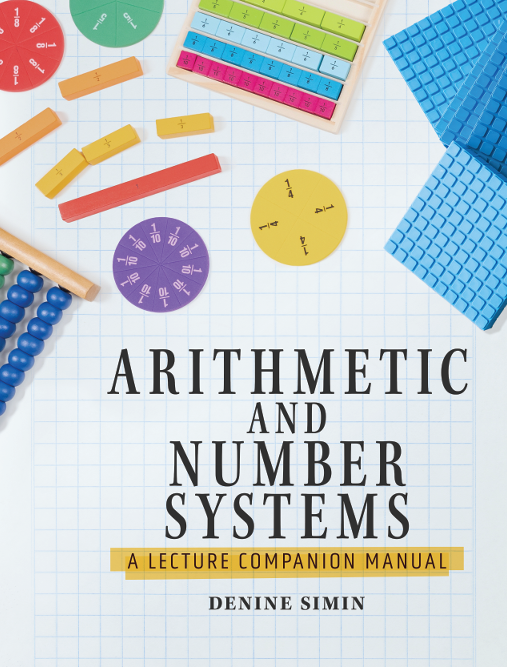Arithmetic and Numbers Systems
Author(s): Denine Simin
Edition: 1
Copyright: 2025
Pages: 358
UNIT I Problem-Solving and Patterns
A. Polya’s Four Steps in Problem Solving
B. Problem Solving Activities
a. Dart Board
b. Buckets of Water
c. More Buckets of Water
d. Balance the Chips
e. Coffee and Muffins
f. Bingo Chips
g. Pentominos
h. Triangular Numbers
i. Quadruplets
j. Fleas and Bikes
k. Sequences
l. Pickleball Tournament
m. Follow the Pattern
n. Square and Pentagonal Numbers
o. Oblong Numbers
p. Even Numbers
q. Square Pattern
r. Shoes and Vocabulary
s. Cubes and Cannonballs
t. Fences and T-shirts
u. Paint and Pets
v. Mental Math
UNIT II Sets
A. Introductory Activity #1: Classroom Venn Diagram – Two sets
B. Introductory Activity #2: Classroom Venn Diagram – Three sets
C. Set Theory
D. Venn Diagrams and Operations on Sets
E. Shading Venn Diagram Activity
F. Attribute Block Activity
G. Venn Diagram Word Problems with Three Circles
H. Relations and Functions
I. Homework
J. Answers
UNIT III Properties
A. Sets of Numbers
B. Operations of Sets of Numbers
C. Properties of Numbers
a. Closure Property
b. Commutative Property
i. Commutative property of Addition
ii. Commutative property of Multiplication
c. Associative Property
i. Associative property of Addition
ii. Associative property of Multiplication
iii. Commutative or Associative Property—Which is it?
iv. Mental Math Activity for Addition—Compose & Decompose
d. Existence of Identity Elements
i. Additive Identity
ii. Multiplicative Identity
e. Existence of Inverses
i. Additive Inverses
ii. Multiplicative Inverses
f. Distributive Property of Multiplication
i. Distributive Property of Multiplication over Addition
ii. Distributive Property of Multiplication over Subtraction iii. Mental Math Activity for Multiplication
g. Zero Property of Multiplication
D. Homework
E. Answers
UNIT IV Place Value
A. Hindu Arabic Numeration System
a. Characteristics
b. Place Value
c. Place Value Chart with Fractions, Decimals, and Negative Exponents
d. Place Value Chart with Whole and Decimal Parts
B. Base Five Numerals
a. Pictorial and Symbolic Representations
b. Convert Between Bases
C. Homework
D. Answers
UNIT V Arithmetic Models
A. Addition
a. Union of Two Sets Approach
B. Subtraction
a. Take Away Approach
b. Alternate Subtraction Definition (Missing Addend Approach)
c. Add the Opposite Approach
C. Multiplication
a. Repeated Addition/Repeated Take-Away Approach
b. Rectangular Array Approach
D. Division
a. Sharing/Partitive1 (Partitioning) Approach
b. Measurement subtractive (Repeated Subtraction) Approach
c. Rectangular Array Approach
E. Homework
F. Answers
UNIT VI Rational and Irrational Numbers
A. Ordering
B. Hierarchy of Arithmetic Operations
C. Absolute Value
D. Divisibility
a. Sieve or Eratosthenes
b. Fundamental Theorem of Arithmetic
c. Greatest Common Factor and Least Common Multiple
E. Fractions
a. Representing fractions
b. Adding and Subtracting Fractions
c. Multiplying and Dividing Fractions
i. Multiplication
ii. Division
iii. Division of Fractions Practice
iv. Answers to Division of Fractions Practice
F. Decimals
a. Connecting Fraction Squares and Decimal Squares
b. Convert from Fractions to Decimals
c. Convert from Decimals to Fractions
G. Percents
a. Convert Fractions to Percents
b. Convert between Fractions, Decimals, Percents
c. Percent Word Problems
H. Homework
I. Answers
UNIT I Problem-Solving and Patterns
A. Polya’s Four Steps in Problem Solving
B. Problem Solving Activities
a. Dart Board
b. Buckets of Water
c. More Buckets of Water
d. Balance the Chips
e. Coffee and Muffins
f. Bingo Chips
g. Pentominos
h. Triangular Numbers
i. Quadruplets
j. Fleas and Bikes
k. Sequences
l. Pickleball Tournament
m. Follow the Pattern
n. Square and Pentagonal Numbers
o. Oblong Numbers
p. Even Numbers
q. Square Pattern
r. Shoes and Vocabulary
s. Cubes and Cannonballs
t. Fences and T-shirts
u. Paint and Pets
v. Mental Math
UNIT II Sets
A. Introductory Activity #1: Classroom Venn Diagram – Two sets
B. Introductory Activity #2: Classroom Venn Diagram – Three sets
C. Set Theory
D. Venn Diagrams and Operations on Sets
E. Shading Venn Diagram Activity
F. Attribute Block Activity
G. Venn Diagram Word Problems with Three Circles
H. Relations and Functions
I. Homework
J. Answers
UNIT III Properties
A. Sets of Numbers
B. Operations of Sets of Numbers
C. Properties of Numbers
a. Closure Property
b. Commutative Property
i. Commutative property of Addition
ii. Commutative property of Multiplication
c. Associative Property
i. Associative property of Addition
ii. Associative property of Multiplication
iii. Commutative or Associative Property—Which is it?
iv. Mental Math Activity for Addition—Compose & Decompose
d. Existence of Identity Elements
i. Additive Identity
ii. Multiplicative Identity
e. Existence of Inverses
i. Additive Inverses
ii. Multiplicative Inverses
f. Distributive Property of Multiplication
i. Distributive Property of Multiplication over Addition
ii. Distributive Property of Multiplication over Subtraction iii. Mental Math Activity for Multiplication
g. Zero Property of Multiplication
D. Homework
E. Answers
UNIT IV Place Value
A. Hindu Arabic Numeration System
a. Characteristics
b. Place Value
c. Place Value Chart with Fractions, Decimals, and Negative Exponents
d. Place Value Chart with Whole and Decimal Parts
B. Base Five Numerals
a. Pictorial and Symbolic Representations
b. Convert Between Bases
C. Homework
D. Answers
UNIT V Arithmetic Models
A. Addition
a. Union of Two Sets Approach
B. Subtraction
a. Take Away Approach
b. Alternate Subtraction Definition (Missing Addend Approach)
c. Add the Opposite Approach
C. Multiplication
a. Repeated Addition/Repeated Take-Away Approach
b. Rectangular Array Approach
D. Division
a. Sharing/Partitive1 (Partitioning) Approach
b. Measurement subtractive (Repeated Subtraction) Approach
c. Rectangular Array Approach
E. Homework
F. Answers
UNIT VI Rational and Irrational Numbers
A. Ordering
B. Hierarchy of Arithmetic Operations
C. Absolute Value
D. Divisibility
a. Sieve or Eratosthenes
b. Fundamental Theorem of Arithmetic
c. Greatest Common Factor and Least Common Multiple
E. Fractions
a. Representing fractions
b. Adding and Subtracting Fractions
c. Multiplying and Dividing Fractions
i. Multiplication
ii. Division
iii. Division of Fractions Practice
iv. Answers to Division of Fractions Practice
F. Decimals
a. Connecting Fraction Squares and Decimal Squares
b. Convert from Fractions to Decimals
c. Convert from Decimals to Fractions
G. Percents
a. Convert Fractions to Percents
b. Convert between Fractions, Decimals, Percents
c. Percent Word Problems
H. Homework
I. Answers

